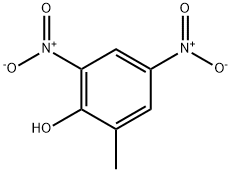534-52-1

Product Name:
2-Methyl-4,6-dinitrophenol
Formula:
C7H6N2O5
Synonyms:
DNC;DNOC;2-Methyl-4,6-dinitrophenol;4,6-Dinitro-2-methylphenol;3,5-Dinitro-2-hydroxytoluene
Inquiry
CHEMICAL AND PHYSICAL PROPERTIES
| Physical Description | 4,6-dinitro-o-cresol appears as a yellow solid. Emits toxic oxides of nitrogen fumes when heated to decomposition. Toxic by skin absorption, inhalation or ingestion. Soluble in alcohol, acetone, ether and solutions of sodium or potassium hydroxides. |
|---|---|
| Color/Form | Yellow prisms or needles from alcohol |
| Odor | Odorless |
| Boiling Point | 594 °F at 760 mmHg (EPA, 1998) |
| Melting Point | 190 °F (NIOSH, 2023) |
| Flash Point | None (EPA, 1998) |
| Solubility | 0.01 % (NIOSH, 2023) |
| Density | greater than 1.1 at 68 °F (est) (USCG, 1999) |
| Vapor Density | 6.82 (EPA, 1998) - Heavier than air; will sink (Relative to Air) |
| Vapor Pressure | 5e-05 mmHg (EPA, 1998) |
| LogP | log Kow = 2.13 |
| Henry's Law Constant | Henry's Law constant: 1.40X10-6 atm cu m/mol at 25 °C |
| Stability/Shelf Life | Stable under recommended storage conditions. |
| Autoignition Temperature | 340 °C |
| Decomposition | When heated to decomposition it emits toxic fumes of /nitrogen oxides/. |
| Heat of Combustion | -7,050 Btu/lb = -3920 cal/g = -164X10+5 J/kg |
| Dissociation Constants | pKa = 4.31 |
| Kovats Retention Index | 1564 1571.3 1573.1 1617 1617 |
| Other Experimental Properties | Forms salts with inorganic and organic bases; forms molecular compounds with amines, hydrocarbons and phenols; readily reduced to mono-amino derivative, 6-amino-2-methyl-4-nitrophenol. |
| Chemical Classes | Pesticides -> Herbicides, Nitroaromatic |
SAFETY INFORMATION
| Signal word | Danger |
|---|---|
| Pictogram(s) |
 Corrosion Corrosives GHS05  Skull and Crossbones Acute Toxicity GHS06  Health Hazard GHS08  Environment GHS09 |
| GHS Hazard Statements |
H315:Skin corrosion/irritation H317:Sensitisation, Skin H318:Serious eye damage/eye irritation H341:Germ cell mutagenicity H410:Hazardous to the aquatic environment, long-term hazard |
| Precautionary Statement Codes |
P201:Obtain special instructions before use. P273:Avoid release to the environment. P280:Wear protective gloves/protective clothing/eye protection/face protection. P305+P351+P338:IF IN EYES: Rinse cautiously with water for several minutes. Remove contact lenses, if present and easy to do. Continuerinsing. |
COMPUTED DESCRIPTORS
| Molecular Weight | 198.13 g/mol |
|---|---|
| XLogP3 | 2.1 |
| Hydrogen Bond Donor Count | 1 |
| Hydrogen Bond Acceptor Count | 5 |
| Rotatable Bond Count | 0 |
| Exact Mass | 198.02767130 g/mol |
| Monoisotopic Mass | 198.02767130 g/mol |
| Topological Polar Surface Area | 112 Ų |
| Heavy Atom Count | 14 |
| Formal Charge | 0 |
| Complexity | 245 |
| Isotope Atom Count | 0 |
| Defined Atom Stereocenter Count | 0 |
| Undefined Atom Stereocenter Count | 0 |
| Defined Bond Stereocenter Count | 0 |
| Undefined Bond Stereocenter Count | 0 |
| Covalently-Bonded Unit Count | 1 |
| Compound Is Canonicalized | Yes |
PRODUCT INTRODUCTION
description
Dinitrocresols are a class of manufactured chemicals that do not occur naturally in the environment. There are 18 different dinitrocresols. The most commercially important dinitrocresol, 4,6-dinitro-o-cresol (DNOC), is a yellow solid with no smell. It is used primarily for insect control and crop protection. It may be sold under several trade names, including Antinonnin, Detal, and Dinitrol. Use of tradenames is for identification only and does not imply endorsement by the Agency for Toxic Substances and Disease Registry, the Public Health Service, or the U.S. Department of Health and Human Services. DNOC was used in diet pills in the 1930s, but has since been banned for this use.
